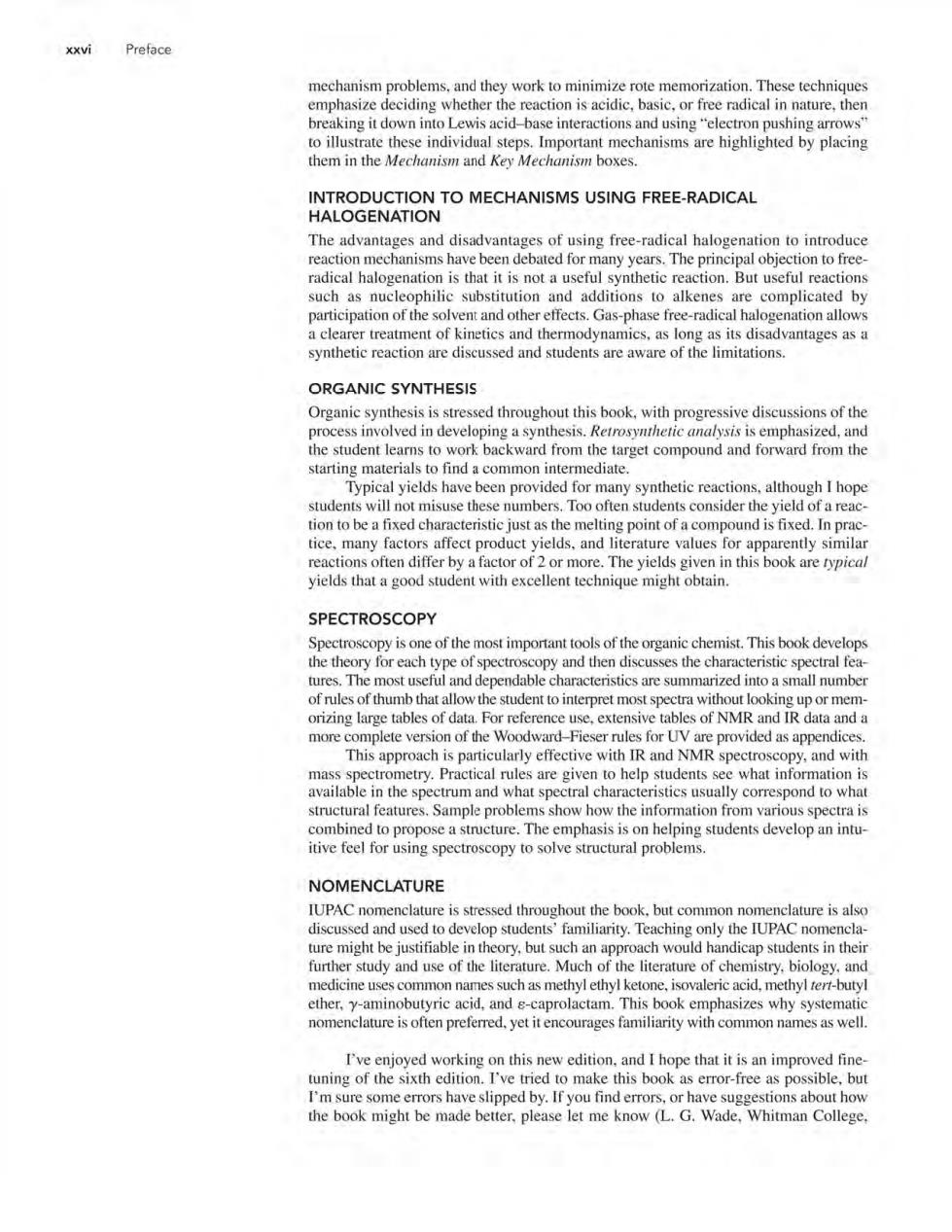正在加载图片...

Preface mechanism problems.and they work to minimize rote memorization.These techniques emphasize deciding whether the reaction is acidic,basic.or free radical in nature,then wn inte sacid-base inter ons and using e Theadanlaesanddikatanmtaecsofsingfeadicalhealoenationoiptrodte such as nucleophilic substitution and additions to alkenes are complicated by participation of the solvent and other effects.Gas-phase free-radical halogenation allows a clearer treatment of kinetics and thermodynamics.as long as its disadvantages asa synthetic reaction are discussed and students are aware of ORGANIC SYNTHESIS Organic synthesis is stressed throughout this book.with progr ssive discussions of the process involved in developing a synthesis.es is emphasized.and the student leamns to work backward from the target compound and forward from the starting material o nind a common tion to be a fixed characteristic just as the melting point of a compound is fixed.In prac tice.many factors affect product yields.and literature values fo ook are rypice mig SPECTROSCOPY tant tools of the nic chemist This book develo tures.The most useful and dependable characteristics are summarized into a small number of rules of thun that a the stdent most spectra withou ndi This approach is particularly effective with IR and NMR spectroscopy,and with what infon ation is e spe how the inf es ust correspond to wn combined to propose a structure.The emphasis is on helping students develop an intu- itive feel for using spectroscopy to solve structural problems NOMENCLATURE IUPAC nomenclature is stressed throughout the book,but common nomenclature is also and use p students.I and medicine uses common names such as methyl ethyl ketone.isovaleric acid,methyl ter-butyl ether,y-aminobutyric acid,and e-caprolactam.This book emphasizes why systema I've enioved working on this new edition.and I hope that it is an improved fine tuning of the sixth edition.I've tried to make this book as error-free as possible,but xxvi Preface mechanism problems, and they work to minimize rote memorization. These techniques emphasize deciding whether the reaction is acidic, basic, or free radical in nature, then breaking it down into Lewis acid-base interactions and using "electron pushing arrows" to illustrate these individual steps. Important mechanisms are highlighted by placing them in the Mechanism and Key Mechanism boxes. INTRODUCTION TO MECHANISMS USING FREE-RADICAL HALOGENATION The advantages and disadvantages of using free-radical halogenation to introduce reaction mechanisms have been debated for many years. The principal objection to freeradical halogenation is that it is not a useful synthetic reaction. But useful reactions such as nucleophilic substitution and additions to alkenes are complicated by participation of the solvent and other effects. Gas-phase free-radical halogenation allows a clearer treatment of kinetics and thermodynamics, as long as its disadvantages as a synthetic reaction are discussed and students are aware of the limitations. ORGANIC SYNTHESIS Organic synthesis is stressed throughout this book, with progressive discussions of the process involved in developing a synthesis. Retrosynthetic analysis is emphasized, and the student learns to work backward from the target compound and forward from the starting materials to find a common intermediate. Typical yields have been provided for many synthetic reactions, although I hope students will not misuse these numbers. Too often students consider the yield of a reaction to be a fixed characteristic just as the melting point of a compound is fixed. In practice, many factors affect product yields, and literature values for apparently similar reactions often differ by a factor of 2 or more. The yields given in this book are typical yields that a good student with excellent technique might obtain. SPECTROSCOPY Spectroscopy is one of the most important tools of the organic chemist. This book develops the theory for each type of spectroscopy and then discusses the characteristic spectral features. The most useful and dependable characteristics are summarized into a small number of rules of thumb that allow the student to interpret most spectra without looking up or memorizing large tables of data. For reference use, extensive tables of NMR and IR data and a more complete version of the Woodward-Fieser rules for UV are provided as appendices. This approach is particularly effective with IR and NMR spectroscopy, and with mass spectrometry. Practical rules are given to help students see what information is available in the spectrum and what spectral characteristics usually correspond to what structural features. Sample problems show how the information from various spectra is combined to propose a structure. The emphasis is on helping students develop an intuitive feel for using spectroscopy to solve structural problems. NOMENCLATURE IUPAC nomenclature is stressed throughout the book, but common nomenclature is also discussed and used to develop students' familiarity. Teaching only the IUPAC nomenclature might be justifiable in theory, but such an approach would handicap students in their further study and use of the literature. Much of the literature of chemistry, biology, and medicine uses common names such as methyl ethyl ketone, isovaleric acid, methyl tert-butyl ether, y-aminobutyric acid, and c:-caprolactam. This book emphasizes why systematic nomenclature is often preferred, yet it encourages familiarity with common names as well. I've enjoyed working on this new edition, and I hope that it is an improved finetuning of the sixth edition. I've tried to make this book as error-free as possible, but I'm sure some errors have slipped by. If you find errors, or have suggestions about how the book might be made better, please let me know (L. G. Wade, Whitman College